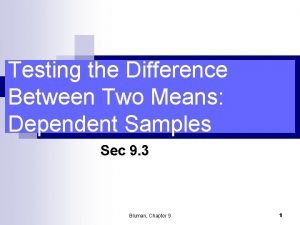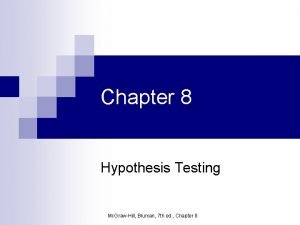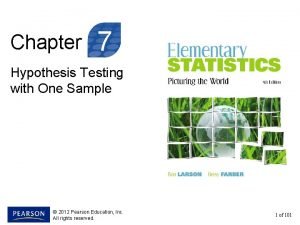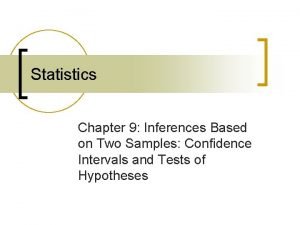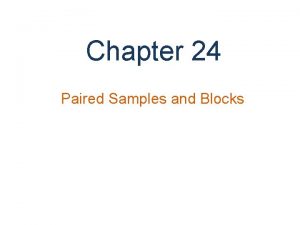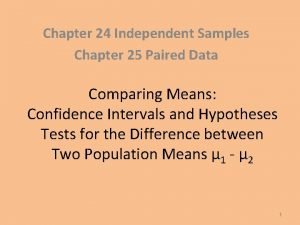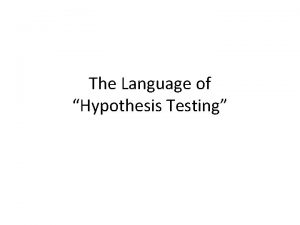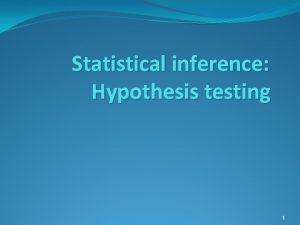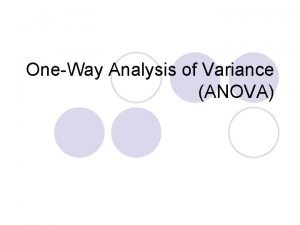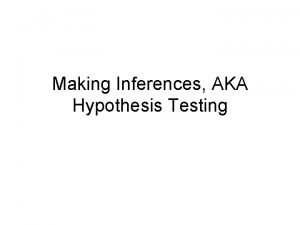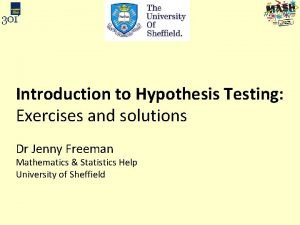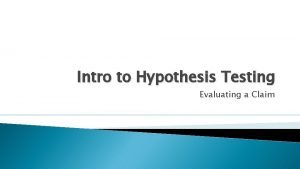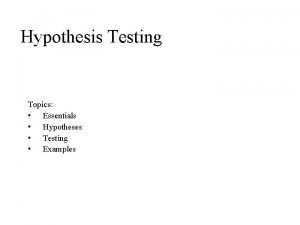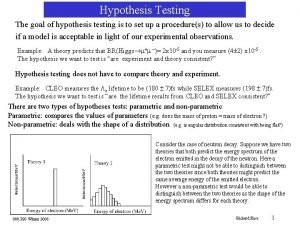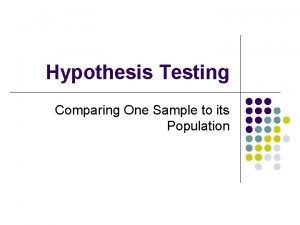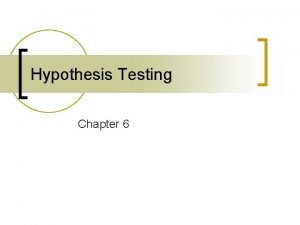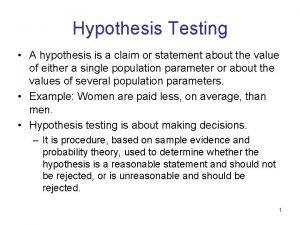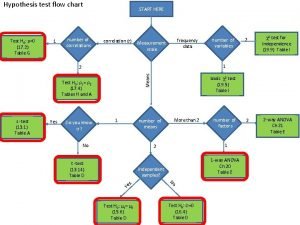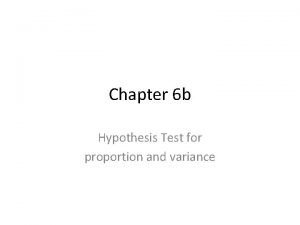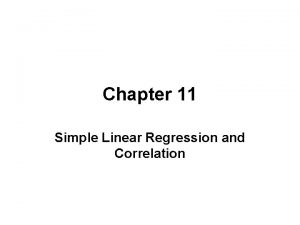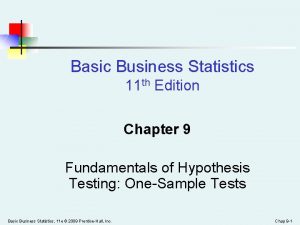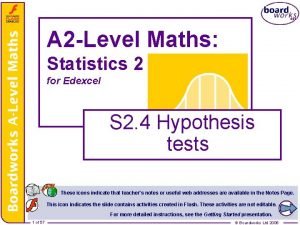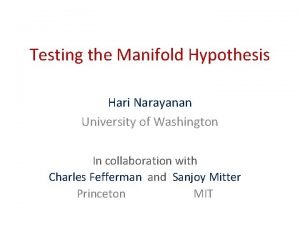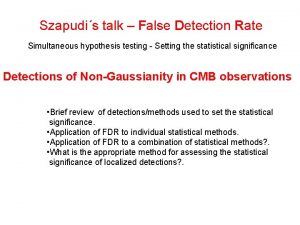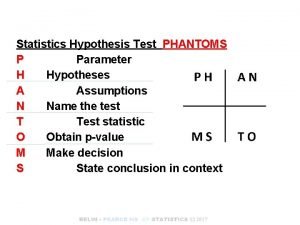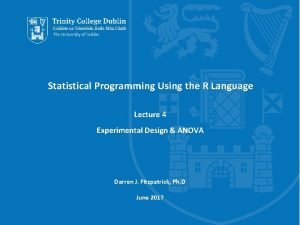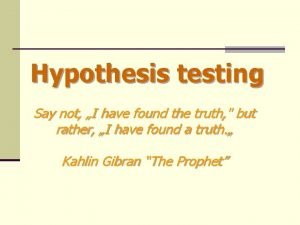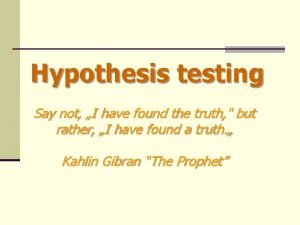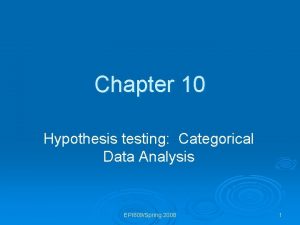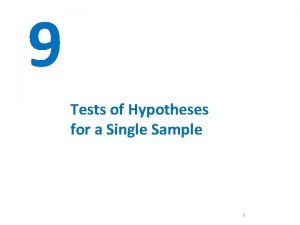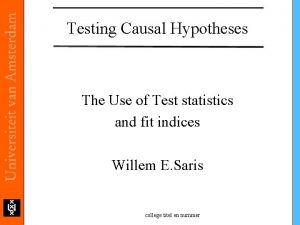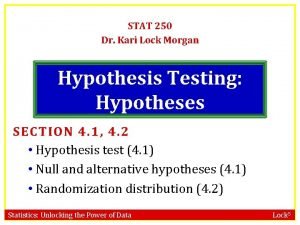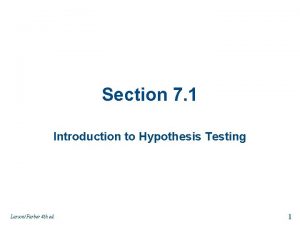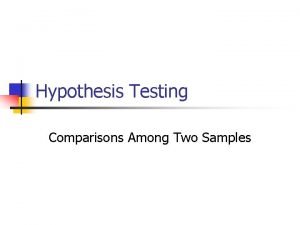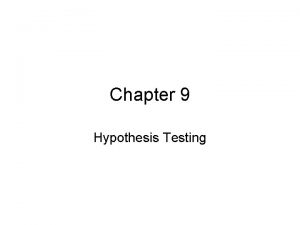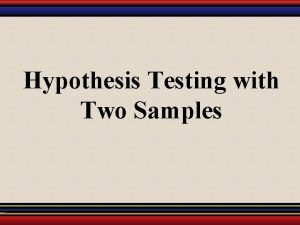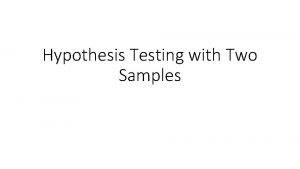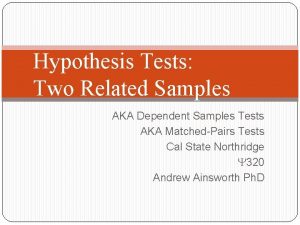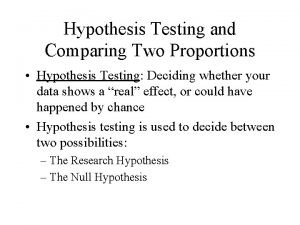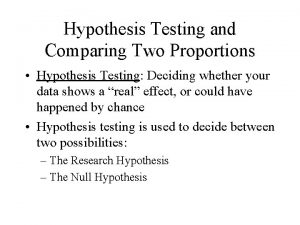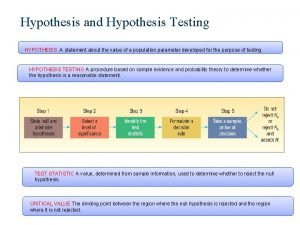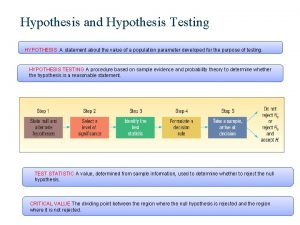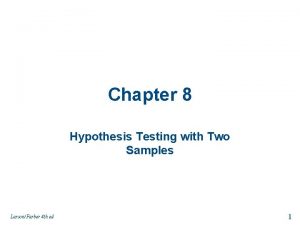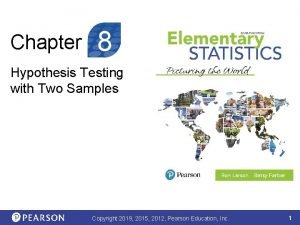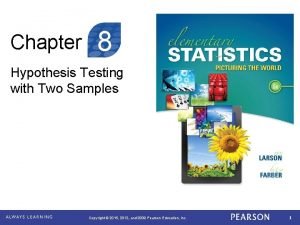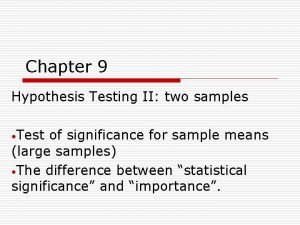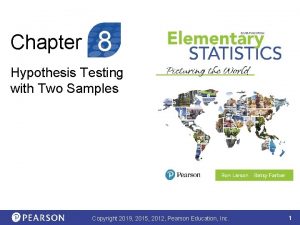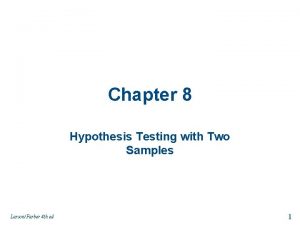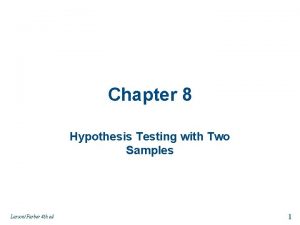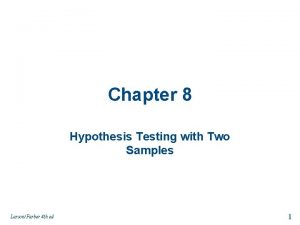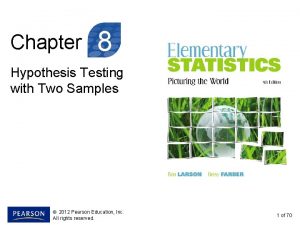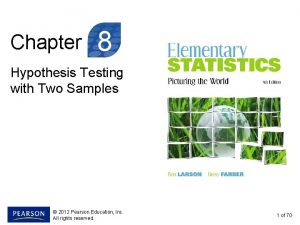Chapter 8 Hypothesis Testing with Two Samples 8











































- Slides: 43

Chapter 8 Hypothesis Testing with Two Samples

§ 8. 1 Testing the Difference Between Means (Large Independent Samples)

Two Sample Hypothesis Testing In a two-sample hypothesis test, two parameters from two populations are compared. For a two-sample hypothesis test, 1. the null hypothesis H 0 is a statistical hypothesis that usually states there is no difference between the parameters of two populations. The null hypothesis always contains the symbol , =, or . 2. the alternative hypothesis Ha is a statistical hypothesis that is true when H 0 is false. The alternative hypothesis always contains the symbol >, , or <. Larson & Farber, Elementary Statistics: Picturing the World, 3 e 3

Two Sample Hypothesis Testing To write a null and alternative hypothesis for a two-sample hypothesis test, translate the claim made about the population parameters from a verbal statement to a mathematical statement. H 0 : μ 1 = μ 2 Ha : μ 1 μ 2 H 0 : μ 1 μ 2 Ha : μ 1 > μ 2 H 0 : μ 1 μ 2 Ha : μ 1 < μ 2 Regardless of which hypotheses used, μ 1 = μ 2 is always assumed to be true. Larson & Farber, Elementary Statistics: Picturing the World, 3 e 4

Two Sample z-Test Three conditions are necessary to perform a z-test for the difference between two population means μ 1 and μ 2. 1. The samples must be randomly selected. 2. The samples must be independent. Two samples are independent if the sample selected from one population is not related to the sample selected from the second population. 3. Each sample size must be at least 30, or, if not, each population must have a normal distribution with a known standard deviation. Larson & Farber, Elementary Statistics: Picturing the World, 3 e 5

Two Sample z-Test If these requirements are met, the sampling distribution for (the difference of the sample means) is a normal distribution with mean and standard error of and Sampling distribution for Larson & Farber, Elementary Statistics: Picturing the World, 3 e 6

Two Sample z-Test Two-Sample z-Test for the Difference Between Means A two-sample z-test can be used to test the difference between two population means μ 1 and μ 2 when a large sample (at least 30) is randomly selected from each population and the samples are independent. The test statistic is and the standardized test statistic is When the samples are large, you can use s 1 and s 2 in place of 1 and 2. If the samples are not large, you can still use a two-sample ztest, provided the populations are normally distributed and the population standard deviations are known. Larson & Farber, Elementary Statistics: Picturing the World, 3 e 7

Two Sample z-Test for the Means Using a Two-Sample z-Test for the Difference Between Means (Large Independent Samples) In Words In Symbols 1. State the claim mathematically. Identify the null and alternative hypotheses. State H 0 and Ha. 2. Specify the level of significance. Identify . 3. Sketch the sampling distribution. 4. Determine the critical value(s). 5. Determine the rejection regions(s). Use Table 4 in Appendix B. Continued. Larson & Farber, Elementary Statistics: Picturing the World, 3 e 8

Two Sample z-Test for the Means Using a Two-Sample z-Test for the Difference Between Means (Large Independent Samples) In Words In Symbols 6. Find the standardized test statistic. 7. Make a decision to reject or fail to reject the null hypothesis. 8. Interpret the decision in the context of the original claim. If z is in the rejection region, reject H 0. Otherwise, fail to reject H 0. Larson & Farber, Elementary Statistics: Picturing the World, 3 e 9

Two Sample z-Test for the Means Example: A high school math teacher claims that students in her class will score higher on the math portion of the ACT then students in a colleague’s math class. The mean ACT math score for 49 students in her class is 22. 1 and the standard deviation is 4. 8. The mean ACT math score for 44 of the colleague’s students is 19. 8 and the standard deviation is 5. 4. At = 0. 10, can the teacher’s claim be supported? H 0: 1 2 = 0. 10 Ha: 1 > 2 (Claim) -3 -2 -1 0 1 2 3 z 0 = 1. 28 Larson & Farber, Elementary Statistics: Picturing the World, 3 e z Continued. 10

Two Sample z-Test for the Means Example continued: H 0: 1 2 Ha: 1 > 2 (Claim) z 0 = 1. 28 -3 -2 -1 0 1 2 The standardized error is 3 z Reject H 0. The standardized test statistic is There is enough evidence at the 10% level to support the teacher’s cla that her students score better on the ACT. Larson & Farber, Elementary Statistics: Picturing the World, 3 e 11

§ 8. 2 Testing the Difference Between Means (Small Independent Samples)

Two Sample t-Test If samples of size less than 30 are taken from normally-distributed populations, a t-test may be used to test the difference between the population means μ 1 and μ 2. Three conditions are necessary to use a t-test for small independent samples. 1. The samples must be randomly selected. 2. The samples must be independent. Two samples are independent if the sample selected from one population is not related to the sample selected from the second population. 3. Each population must have a normal distribution. Larson & Farber, Elementary Statistics: Picturing the World, 3 e 13

Two Sample t-Test Two-Sample t-Test for the Difference Between Means A two-sample t-test is used to test the difference between two population means μ 1 and μ 2 when a sample is randomly selected from each population. Performing this test requires each population to be normally distributed, and the samples should be independent. The standardized test statistic is If the population variances are equal, then information from the two samples is combined to calculate a pooled estimate of the standard deviation Continued. Larson & Farber, Elementary Statistics: Picturing the World, 3 e 14

Two Sample t-Test Two-Sample t-Test (Continued) The standard error for the sampling distribution of is Variances equal and d. f. = n 1 + n 2 – 2. If the population variances are not equal, then the standard error is Variances not equal and d. f = smaller of n 1 – 1 or n 2 – 1. Larson & Farber, Elementary Statistics: Picturing the World, 3 e 15

Normal or t-Distribution? Are both sample sizes least 30? at Yes Use the z-test. No You cannot use the ztest or the t-test. No Are both populations normally distributed? Use the t-test with Yes Are both population standard deviations known? No Are the population variances equal? Yes No Use the z-test. Use the t-test with Yes and d. f = n 1 + n 2 – 2. and d. f = smaller of n 1 – 1 or n 2 – 1. Larson & Farber, Elementary Statistics: Picturing the World, 3 e 16

Two Sample t-Test for the Means Using a Two-Sample t-Test for the Difference Between Means (Small Independent Samples) In Words In Symbols 1. State the claim mathematically. Identify the null and alternative hypotheses. State H 0 and Ha. 2. Specify the level of significance. Identify . 3. Identify the degrees of freedom and sketch the sampling distribution. d. f. = n 1+ n 2 – 2 or d. f. = smaller of n 1 – 1 or n 2 – 1. 4. Determine the critical value(s). Use Table 5 in Appendix B. Continued. Larson & Farber, Elementary Statistics: Picturing the World, 3 e 17

Two Sample t-Test for the Means Using a Two-Sample t-Test for the Difference Between Means (Small Independent Samples) In Words In Symbols 5. Determine the rejection regions(s). 6. Find the standardized test statistic. 7. Make a decision to reject or fail to reject the null hypothesis. 8. Interpret the decision in the context of the original claim. If t is in the rejection region, reject H 0. Otherwise, fail to reject H 0. Larson & Farber, Elementary Statistics: Picturing the World, 3 e 18

Two Sample t-Test for the Means Example: A random sample of 17 police officers in Brownsville has a mean annual income of $35, 800 and a standard deviation of $7, 800. In Greensville, a random sample of 18 police officers has a mean annual income of $35, 100 and a standard deviation of $7, 375. Test the claim at = 0. 01 that the mean annual incomes in the two cities are not the same. Assume the population variances are equal. H 0: 1 = 2 Ha: 1 2 (Claim) d. f. = n 1 + n 2 – 2 = 17 + 18 – 2 = 33 = 0. 005 -2 -1 –t 0 = – 2. 576 0 1 2 3 t t 0 = 2. 576 Larson & Farber, Elementary Statistics: Picturing the World, 3 e Continued. 19

Two Sample t-Test for the Means Example continued: H 0: 1 = 2 Ha: 1 2 (Claim) -3 -2 -1 –t 0 = – 2. 576 0 1 2 3 t t 0 = 2. 576 The standardized error is Continued. Larson & Farber, Elementary Statistics: Picturing the World, 3 e 20

Two Sample t-Test for the Means Example continued: H 0: 1 = 2 Ha: 1 2 (Claim) -3 -2 -1 –t 0 = – 2. 576 0 1 2 3 t t 0 = 2. 576 The standardized test statistic is Fail to reject H 0. There is not enough evidence at the 1% level to support the claim that the mean annual incomes differ. Larson & Farber, Elementary Statistics: Picturing the World, 3 e 21

§ 8. 3 Testing the Difference Between Means (Dependent Samples)

Independent and Dependent Samples Two samples are independent if the sample selected from one population is not related to the sample selected from the second population. Two samples are dependent if each member of one sample corresponds to a member of the other sample. Dependent samples are also called paired samples or matched samples. Independent Samples Dependent Samples Larson & Farber, Elementary Statistics: Picturing the World, 3 e 23

Independent and Dependent Samples Example: Classify each pair of samples as independent or dependent. Sample 1: The weight of 24 students in a first-grade class Sample 2: The height of the same 24 students These samples are dependent because the weight and height can be paired with respect to each student. Sample 1: The average price of 15 new trucks Sample 2: The average price of 20 used sedans These samples are independent because it is not possible to pair the new trucks with the used sedans. The data represents prices for different vehicles. Larson & Farber, Elementary Statistics: Picturing the World, 3 e 24

t-Test for the Difference Between Means To perform a two-sample hypothesis test with dependent samples, the difference between each data pair is first found: d = x 1 – x 2 Difference between entries for a data pair. The test statistic is the mean of these differences. Mean of the differences between paired data entries in the dependent samples. Three conditions are required to conduct the test. Larson & Farber, Elementary Statistics: Picturing the World, 3 e 25

t-Test for the Difference Between Means 1. The samples must be randomly selected. 2. The samples must be dependent (paired). 3. Both populations must be normally distributed. If these conditions are met, then the sampling distribution for is approximated by a t-distribution with n – 1 degrees of freedom, where n is the number of data pairs. –t 0 μd t 0 Larson & Farber, Elementary Statistics: Picturing the World, 3 e 26

t-Test for the Difference Between Means The following symbols are used for the t-test for Symbol Description The number of pairs of data The difference between entries for a data pair, d = x 1 – x 2 The hypothesized mean of the differences of paired data in the population The mean of the differences between the paired data entries in the dependent samples The standard deviation of the differences between the paired data entries in the dependent samples Larson & Farber, Elementary Statistics: Picturing the World, 3 e 27

t-Test for the Difference Between Means A t-test can be used to test the difference of two population means when a sample is randomly selected from each population. The requirements for performing the test are that each population must be normal and each member of the first sample must be paired with a member of the second sample. The test statistic is and the standardized test statistic is The degrees of freedom are d. f. = n – 1. Larson & Farber, Elementary Statistics: Picturing the World, 3 e 28

t-Test for the Difference Between Means Using the t-Test for the Difference Between Means (Dependent Samples) In Words In Symbols 1. State the claim mathematically. Identify the null and alternative hypotheses. State H 0 and Ha. 2. Specify the level of significance. Identify . 3. Identify the degrees of freedom and sketch the sampling distribution. d. f. = n – 1 4. Determine the critical value(s). Use Table 5 in Appendix B. Continued. Larson & Farber, Elementary Statistics: Picturing the World, 3 e 29

t-Test for the Difference Between Means Using a Two-Sample t-Test for the Difference Between Means (Small Independent Samples) In Words In Symbols 5. Determine the rejection region(s). 6. Calculate and Use a table. 7. Find the standardized test statistic. Larson & Farber, Elementary Statistics: Picturing the World, 3 e 30

t-Test for the Difference Between Means Using a Two-Sample t-Test for the Difference Between Means (Small Independent Samples) In Words In Symbols 8. Make a decision to reject or fail to reject the null hypothesis. If t is in the rejection region, reject H 0. Otherwise, fail to reject H 0. 9. Interpret the decision in the context of the original claim. Larson & Farber, Elementary Statistics: Picturing the World, 3 e 31

t-Test for the Difference Between Means Example: A reading center claims that students will perform better on a standardized reading test after going through the reading course offered by their center. The table shows the reading scores of 6 students before and after the course. At = 0. 05, is there enough evidence to conclude that the students’ scores after the course are better than the scores before the course? Student 1 2 3 4 5 6 Score (before) 85 96 70 76 81 78 Score (after) 88 85 89 86 92 89 H 0: d 0 Ha: d > 0 (Claim) Larson & Farber, Elementary Statistics: Picturing the World, 3 e Continued. 32

t-Test for the Difference Between Means Example continued: H 0: d 0 d. f. = 6 – 1 = 5 = 0. 05 Ha: d > 0 (Claim) d = (score before) – (score after) Student Score (before) Score (after) d d 2 -3 -2 -1 0 1 2 t 3 t 0 = 2. 015 1 2 3 4 5 6 85 96 70 76 81 78 88 85 89 86 92 89 3 11 19 10 11 11 9 121 361 100 121 Continued. Larson & Farber, Elementary Statistics: Picturing the World, 3 e 33

t-Test for the Difference Between Means Example continued: H 0: d 0 Ha: d > 0 (Claim) -3 -2 -1 0 1 The standardized test statistic is 2 3 t t 0 = 2. 015 Fail to reject H 0. There is not enough evidence at the 5% level to support the claim that the students’ scores after the course are better than the scores before the course. Larson & Farber, Elementary Statistics: Picturing the World, 3 e 34

§ 8. 4 Testing the Difference Between Proportions

Two Sample z-Test for Proportions A z-test is used to test the difference between two population proportions, p 1 and p 2. Three conditions are required to conduct the test. 1. The samples must be randomly selected. 2. The samples must be independent. 3. The samples must be large enough to use a normal sampling distribution. That is, n 1 p 1 5, n 1 q 1 5, n 2 p 2 5, and n 2 q 2 5. Larson & Farber, Elementary Statistics: Picturing the World, 3 e 36

Two Sample z-Test for Proportions If these conditions are met, then the sampling distribution for is a normal distribution with mean and standard error A weighted estimate of p 1 and p 2 can be found by using Larson & Farber, Elementary Statistics: Picturing the World, 3 e 37

Two Sample z-Test for Proportions Two Sample z-Test for the Difference Between Proportions A two sample z-test is used to test the difference between two population proportions p 1 and p 2 when a sample is randomly selected from each population. The test statistic is and the standardized test statistic is where Larson & Farber, Elementary Statistics: Picturing the World, 3 e 38

Two Sample z-Test for Proportions Using a Two-Sample z-Test for the Difference Between Proportions In Words In Symbols 1. State the claim. Identify the null and alternative hypotheses. State H 0 and Ha. 2. Specify the level of significance. Identify . 3. Determine the critical value(s). Use Table 4 in Appendix B. 4. Determine the rejection region(s). 5. Find the weighted estimate of p 1 and p 2. Continued. Larson & Farber, Elementary Statistics: Picturing the World, 3 e 39

Two Sample z-Test for Proportions Using a Two-Sample z-Test for the Difference Between Proportions In Words In Symbols 6. Find the standardized test statistic. 7. Make a decision to reject or fail to reject the null hypothesis. 8. Interpret the decision in the context of the original claim. If z is in the rejection region, reject H 0. Otherwise, fail to reject H 0. Larson & Farber, Elementary Statistics: Picturing the World, 3 e 40

Two Sample z-Test for Proportions Example: A recent survey stated that male college students smoke less than female college students. In a survey of 1245 male students, 361 said they smoke at least one pack of cigarettes a day. In a survey of 1065 female students, 341 said they smoke at least one pack a day. At = 0. 01, can you support the claim that the proportion of male college students who smoke at least one pack of cigarettes a day is lower then the proportion of female college students who smoke at least one pack a day? = 0. 01 H 0: p 1 p 2 Ha: p 1 < p 2 (Claim) -3 -2 -1 z 0 = 2. 33 0 1 Larson & Farber, Elementary Statistics: Picturing the World, 3 e 2 3 z Continued. 41

Two Sample z-Test for Proportions Example continued: H 0: p 1 p 2 Ha: p 1 < p 2 (Claim) -3 -2 -1 z 0 = 2. 33 0 1 2 3 z Because 1245(0. 304), 1245(0. 696), 1065(0. 304), and 1065(0. 696) are all at least 5, we can use a two-sample z-test. Continued. Larson & Farber, Elementary Statistics: Picturing the World, 3 e 42

Two Sample z-Test for Proportions Example continued: H 0: p 1 p 2 Ha: p 1 < p 2 (Claim) -3 -2 -1 z 0 = 2. 33 0 1 2 3 z Fail to reject H 0. There is not enough evidence at the 1% level to support the claim that the proportion of male college students who smoke is lower then the proportion of female college students who smoke. Larson & Farber, Elementary Statistics: Picturing the World, 3 e 43
 A dietitian wishes to see if a person's cholesterol
A dietitian wishes to see if a person's cholesterol Chapter 8 hypothesis testing
Chapter 8 hypothesis testing Chapter 7 hypothesis testing with one sample answers
Chapter 7 hypothesis testing with one sample answers Inferences based on two samples
Inferences based on two samples Uji median 2 sampel independen
Uji median 2 sampel independen Hypothesis of the study example
Hypothesis of the study example Alternative hypothesis
Alternative hypothesis Null hypothesis example
Null hypothesis example Weakness of protoplanet hypothesis
Weakness of protoplanet hypothesis Chapter 24 paired samples and blocks
Chapter 24 paired samples and blocks Chapter 25 paired samples and blocks
Chapter 25 paired samples and blocks Chapter 25 paired samples and blocks
Chapter 25 paired samples and blocks The language of hypothesis testing
The language of hypothesis testing Inference hypothesis testing
Inference hypothesis testing One way anova test hypothesis
One way anova test hypothesis Hypothesis testing assignment
Hypothesis testing assignment Hypothesis testing
Hypothesis testing Critical value hypothesis testing
Critical value hypothesis testing Null hypothesis assumptions
Null hypothesis assumptions Critical value hypothesis testing
Critical value hypothesis testing Goal of hypothesis testing
Goal of hypothesis testing Hypothesis type 1 error
Hypothesis type 1 error Null hypothesis formula
Null hypothesis formula Six steps of hypothesis testing
Six steps of hypothesis testing What is the claim in hypothesis testing
What is the claim in hypothesis testing Statistics hypothesis testing flow chart
Statistics hypothesis testing flow chart Hypothesis testing for population proportion
Hypothesis testing for population proportion Slope hypothesis testing
Slope hypothesis testing Business statistics hypothesis testing
Business statistics hypothesis testing Edexcel a level maths hypothesis testing
Edexcel a level maths hypothesis testing Manifold hypothesis
Manifold hypothesis Hypothesis testing in r
Hypothesis testing in r An insurance company checks police records on 582 accidents
An insurance company checks police records on 582 accidents Hypothesis testing in r
Hypothesis testing in r One way two way anova
One way two way anova Hypothesis testing excel
Hypothesis testing excel Create a meme about concepts in hypothesis testing
Create a meme about concepts in hypothesis testing Hypothesis testing for variance
Hypothesis testing for variance Finding test statistic
Finding test statistic Categorical data hypothesis testing
Categorical data hypothesis testing Statistical test meaning
Statistical test meaning Causal hypothesis testing
Causal hypothesis testing Kari is testing the hypothesis
Kari is testing the hypothesis Example of null hypothesis
Example of null hypothesis
